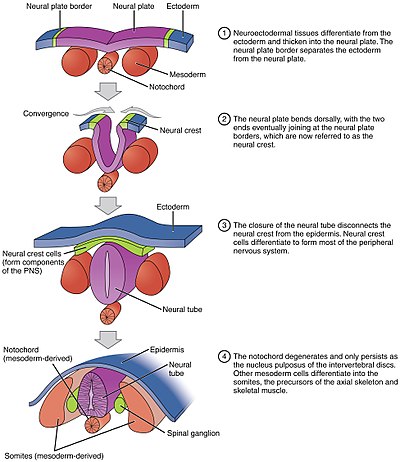Neurulation
| Neurulation | |
|---|---|

Transverse sections that show the progression of the neural plate to the neural groove from bottom to top
|
|
|
Anatomical terminology
[]
|
Neurulation refers to the folding process in vertebrate embryos, which includes the transformation of the neural plate into the neural tube. The embryo at this stage is termed the neurula.
The process begins when the induces the formation of the central nervous system (CNS) by signaling the ectoderm germ layer above it to form the thick and flat neural plate. The neural plate folds in upon itself to form the neural tube, which will later differentiate into the spinal cord and the brain, eventually forming the central nervous system.
Different portions of the neural tube form by two different processes, called primary and secondary neurulation, in different species.
Primary neurulation occurs in response to soluble growth factors secreted by the . Ectodermal cells are induced to form neuroectoderm from a variety of signals. Ectoderm sends and receives signals of bone morphogenetic protein 4 (BMP4) and cells which receive BMP4 signal develop into epidermis. The inhibitory signals chordin, noggin and follistatin are needed to form neural plate. These inhibitory signals are created and emitted by the Spemann's organiser. Cells which do not receive BMP4 signaling due to the effects of the inhibitory signals will develop into the anterior neuroectoderm cells of the neural plate. Cells which receive fibroblast growth factor (FGF) in addition to the inhibitory signals form posterior neural plate cells.
The cells of the neural plate are signaled to become high-columnar and can be identified through microscopy as different from the surrounding epiblastic ectoderm. The cells move laterally and away from the central axis and change into a truncated pyramid shape. This pyramid shape is achieved through tubulin and actin in the apical portion of the cell which constricts as they move. The variation in cell shapes is partially determined by the location of the nucleus within the cell, causing bulging in areas of the cells forcing the height and shape of the cell to change. This process is known as apical constriction
...
Wikipedia
